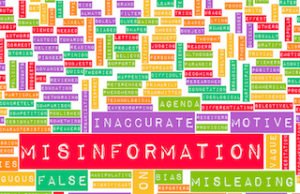After being convicted several years ago for selling an annuity to a woman later diagnosed with dementia, Glenn Neasham faced a reputation crisis. He probably didn’t need to do much analysis to know his good name had been seriously tarnished. But for other advisors with negative content online, a thorough assessment should be the first step on the road to reputation recovery.
Where to begin?
First, take a deep breath and don’t panic. Although it’s stressful to see problematic comments or articles about you on the Internet, don’t bounce from one to the next stressing about their impact. Take a moment to reflect on how you got into this mess. In Neasham’s case, he knew exactly what triggered his crisis. But you might not have the benefit of such clear insight.
Perhaps a group of dissatisfied clients are spreading malicious gossip about you online. Or maybe an unhinged customer is venting about you on Complaints.com. Then again, maybe something you did years ago—say, declaring bankruptcy or getting arrested on misdemeanor charges—has suddenly become visible on the Internet. The point is to get clear about the main driver(s) of your reputation problem. Specifically, consider . . .
- Did you create the crisis yourself? If so, have you taken responsibility for the consequences of your actions and tried to make things right?
- Is a third party trying to harm you? If so, what do you think is motivating this person: anger, greed, jealousy, etc?
Then try to determine if your problem stems from one incident or a pattern of incidents. If the latter, what are the common themes underlying each piece of negative content? If having multiple negative reviews is the concern, are they all stemming from the same or similar causes? Are you prepared to fix the product or service deficiencies that are eroding your reputation?
The point is, try to think through what is happening to you, take ownership, and then get ready to respond rationally rather than emotionally.
Second, quantify and assess your online reputation in great detail. The idea is to get an expansive view of what others can see about you on the Internet. Here are some steps to take:
- Start with a basic Google search of your name and firm name. Most people won’t go much deeper than a page or two into search results. But some may crave more information, so be sure to drill three to four pages down into your search results (10 links per page, for a total of 30 to 40 total links). Click on each link and determine how many mentioned you and/or your business. Then for those that did mention you, indicate whether the mention was positive, negative, or neutral. You may want to establish a spreadsheet to store this information. If you have the time, consider doing the same thing on an alternative search engine such as Bing or Yahoo.
- Now do the same for the common search terms people use to find you online. These might include [“financial advisor” + “retirement planning” + (insert your town’s name)] or [annuities + “insurance agent” + (insert town name)]. Again, record your results on your spreadsheet.
- Next, check the major social networks for mentions about you. Include, but don’t limit yourself to LinkedIn, Twitter, and Facebook.
- Then search on individual websites that have become bastions of consumer feedback. These include sites such as Yelp, Angie’s List, Ripoff Report, and Pissed Consumer, among many others. Also focus on financial-services sites such as WalletHub.com.
Finally, take a deep dive into your online reputation with a free reputation-monitoring tool such as Social Mention or a paid one such as Radian6. These tools will help you drill down into every corner of the Web to uncover the conversations people are having about you, both positive and negative.
Third, having done some basic reflection and assessment of your online footprint, you’re now ready to draw some conclusions about your reputation problem. The goal is to decide if the problem . . .
- is so minor you can ignore it.
- is of medium significance and thus needs your attention soon.
- is of extreme significance, posting a threat to your business survival. In this case, you must treat the problem as if your livelihood depends on it (and it does).
Minor issues can be one or several negative comments on your blog, a criticism or complaint on your Facebook business page, a few negative reviews on Yelp.com or similar consumer-review site. As long as the number of troublesome references are few, most people will write them off as just a normal part of doing business. It’s only when the criticisms are repeated frequently and reach a fever pitch that your response should be more robust.
Medium issues might be a regulatory action for a minor administrative error, a negative comment about you in an article in the trade or general media, or a pattern of negative complaints on a consumer-review site. Here, the negative content might start to have a bigger impact on your reputation due to a regulator questioning your ethics or consumers making vitriolic comments on the open Internet. In these cases, you should take action soon to control the damage.
Extremely significant issues rise to the level of a Glenn Neasham crisis. Here, you might be facing a criminal indictment or damaging skeleton from your past becomes known and goes viral on the Internet. Problems of this nature demand a robust, immediate, and ongoing response.
Fourth, consider the potential virality of the damaging information. In other words, how likely will it spread across the Internet so that thousands or more people in your marketplace might easily view it. The nature of the content will have a big impact on virality. For example, if you are arrested in California for victimizing a senior, you can rest assured it will go viral since the state’s insurance department will promote the incident aggressively to the media. The same will be true if your alleged crime is “sexy”—i.e., you got caught in a $10 million Ponzi scheme and used the proceeds to buy a yacht, three Jaguars, and a chalet in the Swiss Alps.
Also affecting virality is the format of the content itself. A photo or video of you is inherently more viral than a legal document. For example, being led from your house in handcuffs will always spread more quickly than a cease-and-desist order written in legalese and buried on a regulatory website.
Another factor to consider is whether or not the problem appears on a Web platform you control—i.e., your own blog—vs. on the open Internet (e.g. Twitter). In the former case, there’s less viral potential, since an owned platform allows you to isolate the problem and deal with it before others can see it and share with friends and colleagues.
Finally, negative comments made on sites that allow anonymous posters (Twitter) can become more viral than those that require a user’s full identity (Facebook).
In short, frequent complaints or attacks on the open Web, especially those fueled by anonymous comments on an inflammatory topic or in connection with a protected class such as seniors, demand a full-bore response. What’s more, if negative content is now dominating your first-page Google results, then you can be certain the impact on your reputation will be profound. Without corrective measures, your future business prospects might not be promising.
Suffice it to say, you may wish to ignore a minor problem and perhaps deal with a medium problem through do-it-yourself profile and content development, which should push negative material off the first few search results pages. But once a reputation problem rises to the level of extreme, you should consider retaining an online reputation expert. Doing it yourself and hiring out will be the focus of the third and fourth articles in this series.
• See also: How to survive a reputation meltdown: Part I
For more information on ethical sales practices, please visit the National Ethics Association’s Ethics Center. For more information on affordable errors and omissions insurance for low-risk financial advisors, visit E&OforLess.com.













